Blogs
The Pioneer Woman
Tuesday, May 21, 2024 by Phyllis Smith Kester
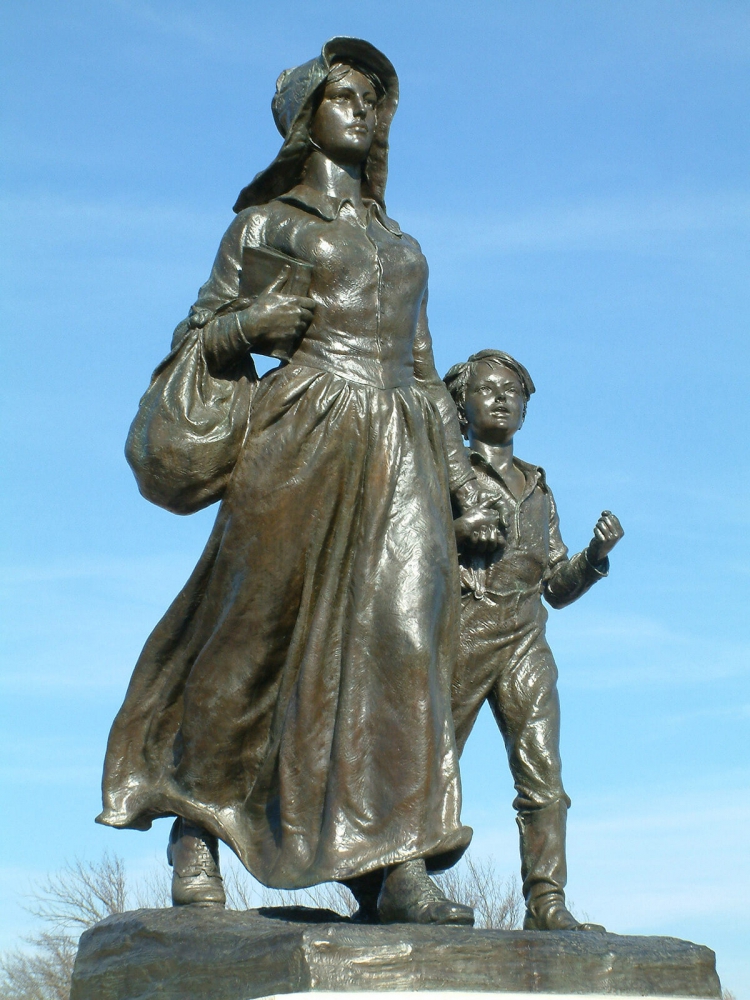 Recently, I found another surprise as I went through one of my mother’s boxes. It was the first sunbonnet I wore as an infant and had a handwritten note my mother had placed inside:
Recently, I found another surprise as I went through one of my mother’s boxes. It was the first sunbonnet I wore as an infant and had a handwritten note my mother had placed inside:
NOTE: “My Granny Hays had a bonnet, so I wanted one like it. She made this one, and when she had her bonnet, I’d go get mine and we were ready to go play outside.
“Was never able to understand why my dad didn’t wear Grannie’s bonnet as mommy did.
“Long before I could talk enough to say what I wanted to do, this bonnet meant ‘Let’s go out.’ She [Phyllis] didn’t always have it on straight, but it went on, then she would get a big one and take it to an adult.” 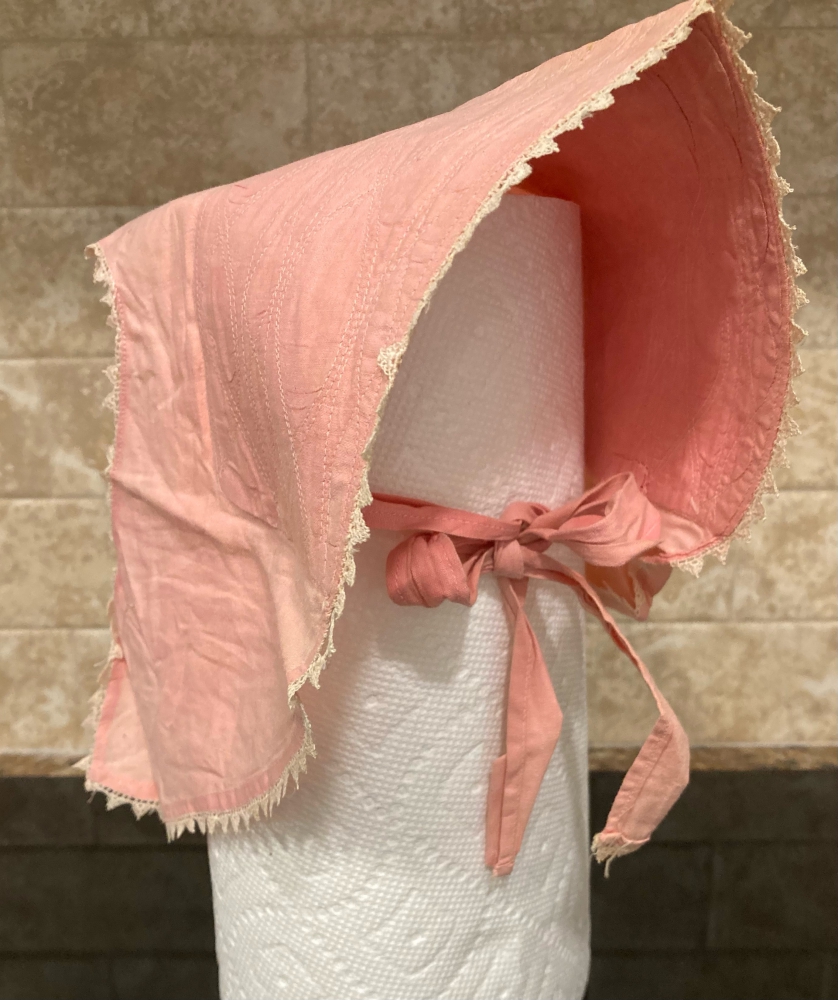
The bonnet seemed fitting since I grew up in Oklahoma and had multiple pictures—with my father, my husband, and later of my children—taken beside the 17-foot-tall bronze sculpture commonly called The Pioneer Woman and designed by Bryant Baker. Erected in Ponca City, Oklahoma, in 1930, the total height is thirty-three feet when you add its stone base. It was constructed decades before the blog or television personality came along by that same name.
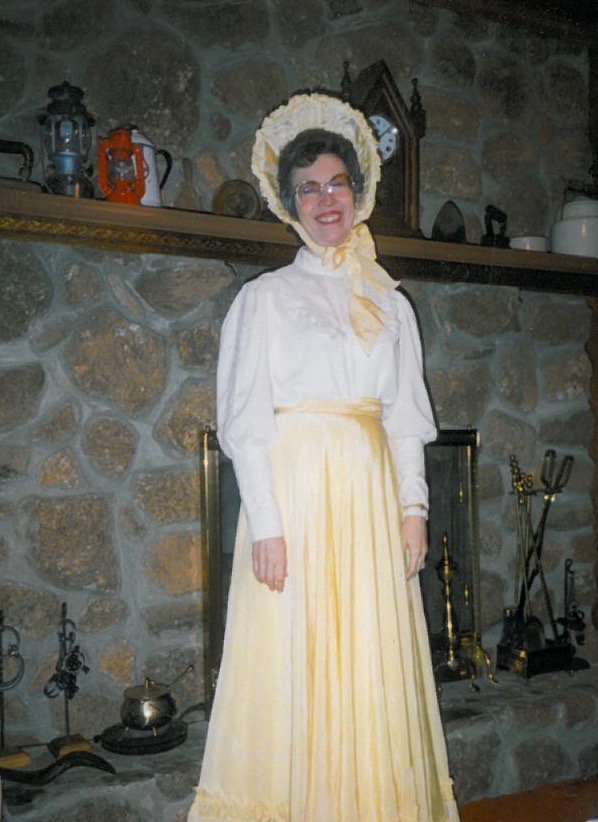
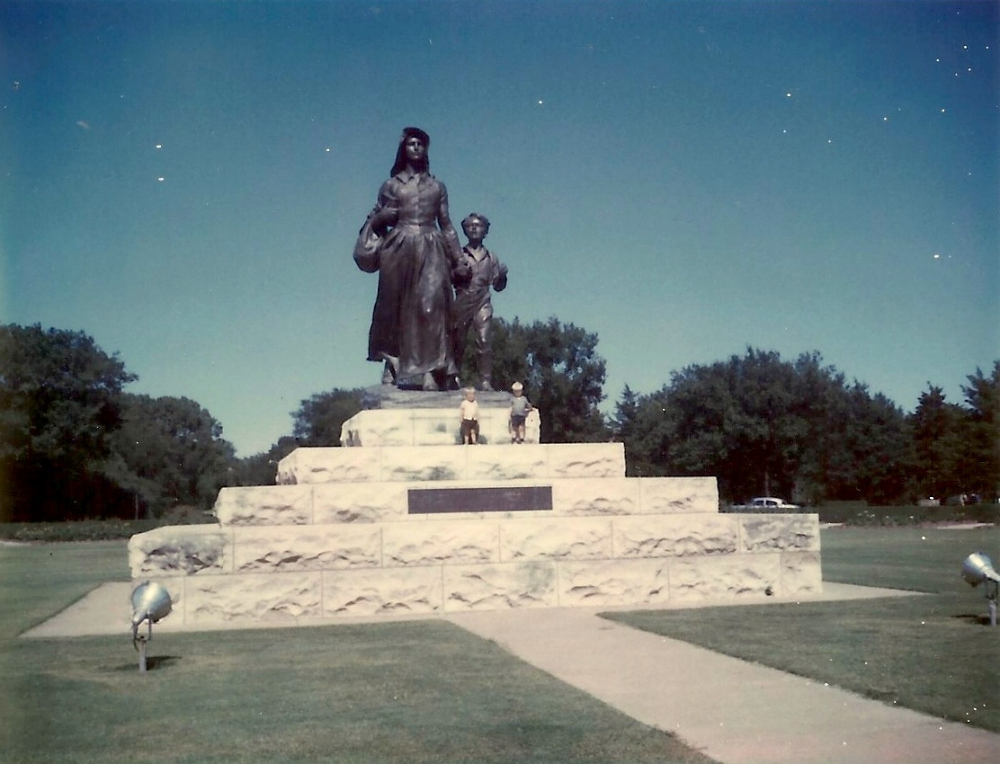
Models of a possible Pioneer Woman statue were commissioned from twelve well-known sculptors. Then, to decide which of the twelve models to use for the final statue, they used feedback and voting by the general public as the models traveled nationwide. The process took years.
While discussing the merits of one of the twelve models over another, some art critics of the day (1920s and 30s) lambasted the sunbonnets as “terrible headwear.” I still chuckle at the response to sunbonnets since their practical nature was ahead of the critics of that day. How different from today since now we recognize the importance of protecting our skin from the sun.
Below the statue is written: “In appreciation of the heroic character of the women who braved the dangers and endured the hardships incident to daily life of the pioneer and homesteader in this country.” The Pioneer Woman stands as a monument to the women who made significant contributions to the forming of our country. They started West with all earthly possessions packed on a horse or wagon.
Both my paternal grandmother Smith and maternal grandmother Hays lived in Oklahoma and had this experience of moving by wagon. However, I still can’t picture my grandmother Hays sitting in a wagon with her small sons behind her and a gun across her lap as she watched the fire her husband built in front of the wagon. He was fishing or trapping to get meat for their meals as they traveled from Tennessee to Oklahoma. I can’t even imagine the gentle grandmother I knew holding a gun. Still, I guess mothers will do many things to protect their children from harm, either the two-legged or four-legged variety.
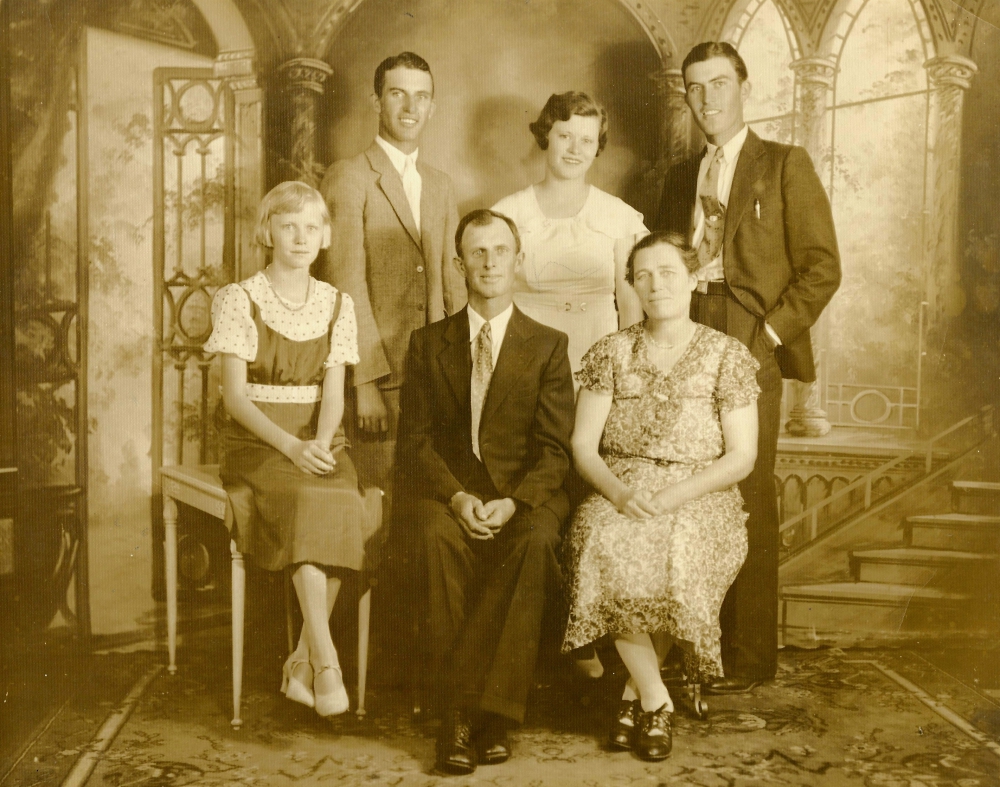

The Pioneer Woman statue pictures a young, sun-bonneted pioneer mother, leading her son by the hand as she courageously strides forward with determination and humility on her face, hope in her heart, and a bible in her hand.
What’s that? A bible, instead of a gun in her hand, as she faced unknown danger? Yes, that’s also a bible you see in the hands of my grandmother Nora Hays in the picture with her seven children.
One famous visitor to America, French sociologist and political theorist Alexis de Tocqueville, spent nine months crisscrossing the United States in 1831 and wrote many observations of our young country. Many politicians, philosophers, and historians have quoted him. However, you don’t often hear how impressed he was with the women he found in America. His writings reflect the same era as the Pioneer Woman.
He held the women in the United States in high regard and reasoned that nowhere would the position of women seem higher. He felt the American woman was full of confidence in her strength and, indeed, a new phenomenon in the history of the world. He thought this resulted from the interaction of Protestantism, long-standing political liberty, and democratic equality.
He praised the well-ordered home life of Americans. In his Democracy in America, he argued that the nation’s political order rested upon this firm domestic foundation.
He believed America somehow succeeded in combining two things that often caused conflict but were marvelously combined in America: the spirit of religion and the spirit of freedom. He further noticed how Americans proceeded at a hectic pace throughout the workweek but strictly observed the Sabbath—in the 1830s, businesses closed so all people could worship freely.
The “hardiness” of young women especially impressed him. He found it amazing that even women raised in refined homes in the East accompanied their restless husbands in their unpredictable quest to go West. He was intrigued by the unique blending of family, faith, and freedom that predominated in the 1830s.
This same theme was mentioned when the Pioneer Woman statue was dedicated in Ponca City when Patrick J. Hurley stated that in evaluating the Pioneer Woman’s character, you had to see that her intelligence quickly “recognized that the three great pillars of democratic government are religion, education and the home. She trusted in God and was a firm believer in the efficacy of prayer.”
If Tocqueville’s insights are accurate (stating that a healthy political environment relies on healthy households), then any genuine attempt to improve America must address the importance of rescuing and revitalizing the family. This is especially crucial as the family is the intermediary between religion and politics. Do we have the same passion as those pioneering women to do whatever it takes?
The LORD is my light and my salvation; whom shall I fear? The LORD is the stronghold of my life; of whom shall I be afraid? (Psalm 27:1 ESV)
Comments
ken nogan From PA At 6/16/2024 6:49:29 AM
An exceptional read. Blessed by the perspective provided.Helen Ann Spessard From C312 WCL At 5/22/2024 6:40:36 PM
My father owned and operated 2 business....one being a very large Wholesale, Retail store. It was opened Monday through Saturday...always closed on Sundays. All stores in Hagerstown , MD. were closed on Sundays until about 1970. It was the large Chain Stores like Walmart that started 7 days .Reply by: Phyllis
True, and now we have 7 workdays instead of only 6.Previous Posts
Dreaming
Phyllis Smith Kester
5/21/2025
Tornado Alley
Phyllis Smith Kester
5/5/2025
Geodes--Part 2
Phyllis Smith Kester
4/23/2025
1940s in Oklahoma
Phyllis Smith Kester
4/8/2025
Buel Overcomes Adversity
Phyllis Smith Kester
3/24/2025
Buel Smith & Pitchers
Phyllis Smith Kester
3/11/2025
Remembering Grandpa Smith
Phyllis Smith Kester
2/26/2025
Meeting Corrie ten Boon
Phyllis Smith Kester
2/10/2025
Walking the Plank
Phyllis Smith Kester
1/28/2025
Train Ride in a Flood
Phyllis Smith Kester
1/13/2025
Saltillo Surprises
Phyllis Smith Kester
1/1/2025
Connecting Two Pictures
Phyllis Smith Kester
12/18/2024
Kintsugi Brokenness & Beauty
Phyllis Smith Kester
12/3/2024
Capillary Action
Phyllis Smith Kester
11/20/2024
A Forge and Anvil
Phyllis Smith Kester
11/5/2024
Tree Analogy #5-Bloom
Phyllis Smith Kester
10/24/2024
Tree Analogy #4: Brokenness
Phyllis Smith Kester
10/9/2024
Israel and Golan Heights
Phyllis Smith Kester
9/25/2024
Tree Analogy #3: Bent Tree
Phyllis Smith Kester
9/11/2024
Lesson From NASA
Phyllis Smith Kester
8/27/2024
Storm Warning
Phyllis Smith Kester
8/14/2024
Tree Analogy #2: Hanging Sod
Phyllis Smith Kester
7/31/2024
Tree Analogy #1: Angel Oak
Phyllis Smith Kester
7/17/2024
The Warning Shot
Phyllis Smith Kester
7/2/2024
Trip's Delayed Surprise
Phyllis Smith Kester
6/18/2024
Antelope Slot Canyon
Phyllis Smith Kester
6/4/2024
The Pioneer Woman
Phyllis Smith Kester
5/21/2024
What is a Woman, a Wife, or a Mother?
Phyllis Smith Kester
5/8/2024
Two Analogies
Phyllis Smith Kester
4/24/2024
Solar Eclipse Analogy
Phyllis Smith Kester
4/10/2024
EASTER
Phyllis Kester
3/26/2024
The Resurrection Plant
Phyllis Smith Kester
3/12/2024
Busted on Pikes Peak
Phyllis Smith Kester
2/27/2024
What is Love?
Phyllis Smith Kester
2/13/2024
Looking, But Not Seeing
Phyllis Kester
1/30/2024
Remembering Christmas 2023
Phyllis Kester
1/16/2024
The Potter
Phyllis Kester
1/2/2024
The Tree Ornament
Phyllis Kester
12/19/2023
Cockapoo Kristy
Phyllis Kester
12/6/2023
Surprises & Obsessions
Phyllis Kester
11/21/2023
Breaking Thru
Phyllis Kester
11/7/2023
Eagles
Phyllis Kester
10/24/2023
Facing Fear
Phyllis Kester
10/10/2023
The Bug-Eyed Monster
Phyllis Kester
9/25/2023
The Flash Flood
Phyllis Kester
9/12/2023
David's Library Book
Phyllis Kester
8/29/2023
Object Lesson: The Leaky Bucket
Phyllis Kester
8/16/2023
Turpentine Creek
Phyllis Kester
8/1/2023
The Surprise
Phyllis Kester
7/17/2023
Small Pleasures
Phyllis Kester
7/4/2023
Are Fathers Important?
Phyllis Kester
6/20/2023
Fathers and Father's Day
Phyllis Smith Kester
6/6/2023
Legacies of my mother, Hallie Hays Smith
Phyllis Smith Kester
5/23/2023
Hallie's Handkerchief Holder
Phyllis Kester
5/9/2023
A Voice from the Past
Phyllis Kester
4/25/2023
Object Lesson: The Crystal Paperweight
Phyllis Kester
4/11/2023
Grandma’s Quilting Bee
Phyllis Kester
3/28/2023
Actions have Consequences
Phyllis Kester
3/14/2023
Hungry Baby
Phyllis Kester
2/28/2023
Married to a Texan
Phyllis Kester
2/14/2023
Charley Kester’s Horses
Phyllis Kester
1/31/2023
Persistence In The Dirt
Phyllis Kester
1/17/2023
Object Lesson: Mushrooms in Our Life
Phyllis Kester
1/3/2023
Trip with Unexpected Twists
Phyllis Kester
12/20/2022
Grandma’s Important Legacy
Phyllis Kester
12/6/2022

